PONTIAC PONTIAC 1996 Owners Manual
Manufacturer: PONTIAC, Model Year: 1996, Model line: PONTIAC, Model: PONTIAC PONTIAC 1996Pages: 370, PDF Size: 17.69 MB
Page 161 of 370
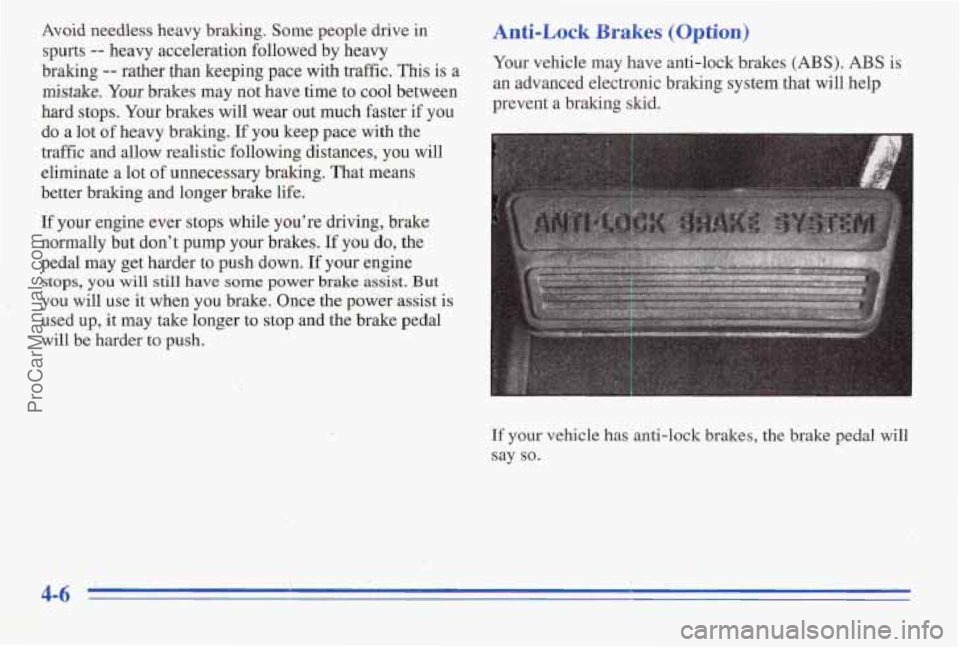
Avoid needless heavy braking. Some people drive in Anti-Lock Brakes (Option)
spurts -- heavy acceleration followedby heavy
braking
-- rather than keeping pace with traffic. This is a
mistake. Your brakes may not have time to cool between
hard
stops. Your brakes will wear out much faster if you
--
Your vehicle may have anti-lock brakes (ABS). ABS is
an advanced electronic
braking system that will help
prevent a braking
skid.
do a lot of heavy braking. If you keep pace with the
traffic and allow realistic following distances, you will
eliminate a lot
of unnecessary braking. That means
better braking and longer brake life.
If your engine ever stops while you're driving', brake
normally
but don't pump your brakes. If you do, the
pedal may get harder to push.down. If your engine
stops, you will still have some power brake assist. But
you will use it when you brake. Once the power assist is
used up, it may take longer to stop and the brake pedal
will
be harder to push.
If your vehicle has anti-lock brakes, the brake pedal will
say so.
I.. ._ . I ..
ProCarManuals.com
Page 162 of 370
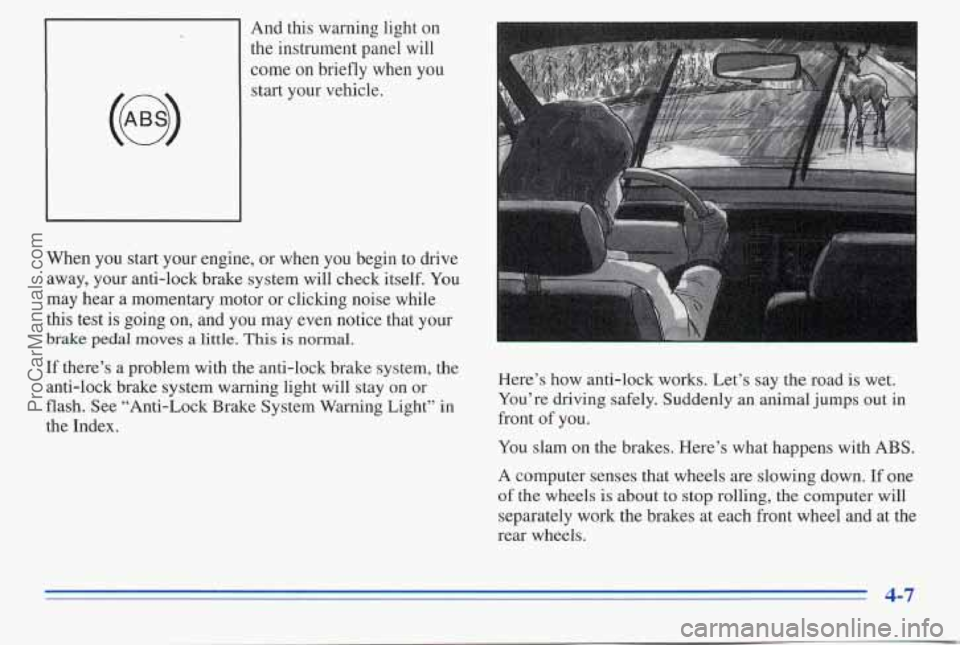
And this warning light on
the instrument panel will
come on briefly when you
start your vehicle.
When you start your engine, or when you begin to drive
away, your anti-lock brake system will check itself. ‘You
may hear a momentary motor or clicking noise while
this test
is going on, and you may even notice that your
brake pedal moves a little. This is normal.
If there’s a problem with the anti-lock brake system, the
anti-lock brake system warning light will stay on or
flash. See “Anti-Lock Brake System Warning Light” in
the Index. Here’s how anti-lock works. Let’s say
the road is wet.
You’re driving safely. Suddenly an animal jumps out in
front of you.
You slam on the brakes. Here’s what happens with
ABS.
A computer senses that wheels are slowing down. If one
of the wheels is about to stop rolling, the computer will
separately work the brakes at each front wheel and at the
rear wheels.
4-7
ProCarManuals.com
Page 163 of 370
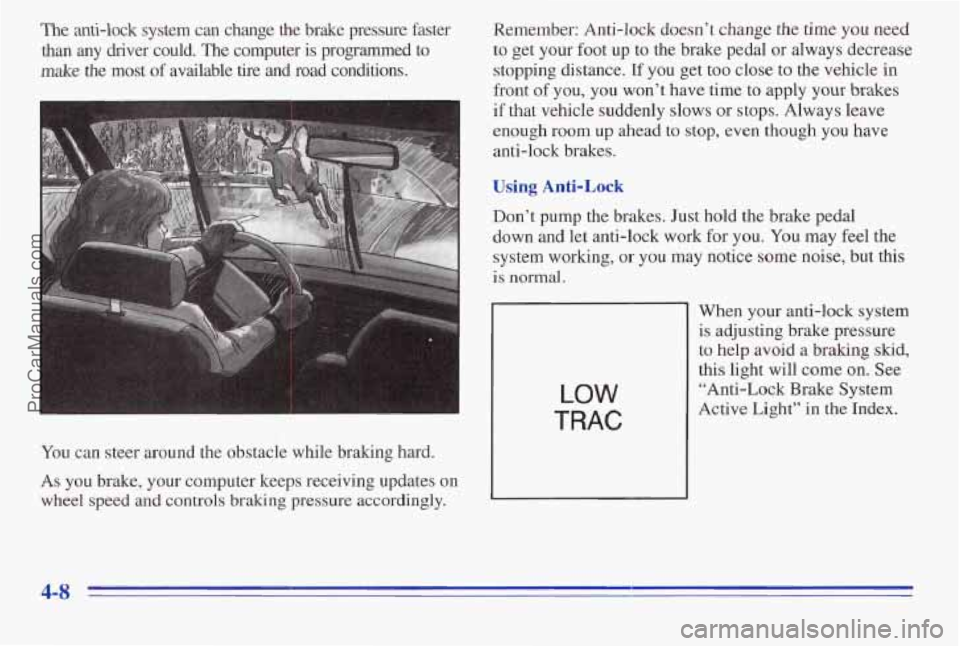
The anti-lock system can change the brake pressure faster
than any driver could. The computer is programmed to
make the most of available tire and road conditions.
You can steer around the obstacle while braking hard.
As you brake, your computer keeps receiving updates on
wheel speed and controls
braking pressure accordingly. Remember: Anti-lock doesn’t
change the time you
need
to get your foot up to the brake pedal or always decrease
stopping distance. If you get too close
to the vehicle in
front
of you, you won’t have time to apply your brakes
if that vehicle suddenly slows or stops. Always leave
enough room up ahead to
stop, even though you have
anti-lock brakes.
Using Anti-Lock
Don’t pump the brakes. Just hold the brake pedal
down and let anti-lock
work for you. You may feel the
system working,
or you may notice some noise, but this
is normal.
LOW
TRAC
When your anti-lock system
is adjusting brake pressure
to help avoid a braking
skid,
this light will come on. See
“Anti-Lock Brake System
Active
Light” in the Index.
4-8
ProCarManuals.com
Page 164 of 370
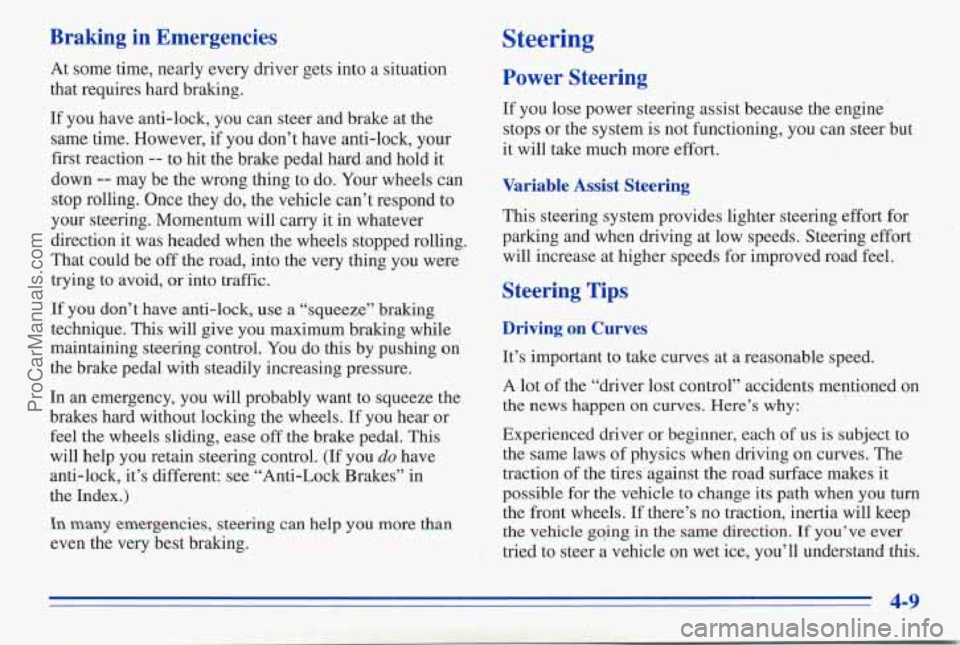
Braking in Emergencies
At some time, nearly every driver gets into a situation
that requires hard braking.
If you have anti-lock, you can steer and brake at the
same time. However,
if you don’t have anti-lock, your
first reaction
-- to hit the brake pedal hard and hold it
down
-- may be the wrong thing to do. Your wheels can
stop rolling. Once they do, the vehicle can’t respond to
your steering. Momentum will
carry it in whatever
direction it was headed when the wheels stopped rolling.
That could be off the road, into the very thing you were
trying to avoid, or into traffic.
If you don’t have anti-lock, use
a “squeeze” braking
technique.
This will give you maximum braking while
maintaining steering control. You do this by pushing on
the brake pedal with steadily increasing pressure.
In an emergency, you will probably want to squeeze the
brakes hard without locking the wheels. If you hear or
feel the wheels sliding, ease
off the brake pedal. This
will help you retain steering control. (If you
do have
anti-lock, it’s different: see “Anti-Lock Brakes” in
the Index.)
In many emergencies, steering can help you more than
even the very best braking.
Steering
Power Steering
If you lose power steering assist because the engine‘
stops or the system is not functioning, you can steer but
it will take much more effort.
Variable Assist Steering
This steering system provides lighter steering effort for
parking and when driving at low speeds. Steering effort
will increase at higher speeds for improved road feel.
Steering Tips
Driving on Curves
It’s important to take curves at a reasonable speed.
A lot of the “driver lost control” accidents mentioned on
the news happen on curves. Here’s why:
Experienced driver or beginner, each of us is subject to
the same laws
of physics when driving on curves. The
traction of the tires against the road surface makes it
possible for the vehicle to change its path when you turn
the front wheels. If there’s no traction, inertia will keep
the vehicle gqing in the same direction. If you’ve ever
. . ,,: ., .. %
A,. .c .. j: tried to steer a vehicle on wet ice, you’ll understand this.
ProCarManuals.com
Page 165 of 370
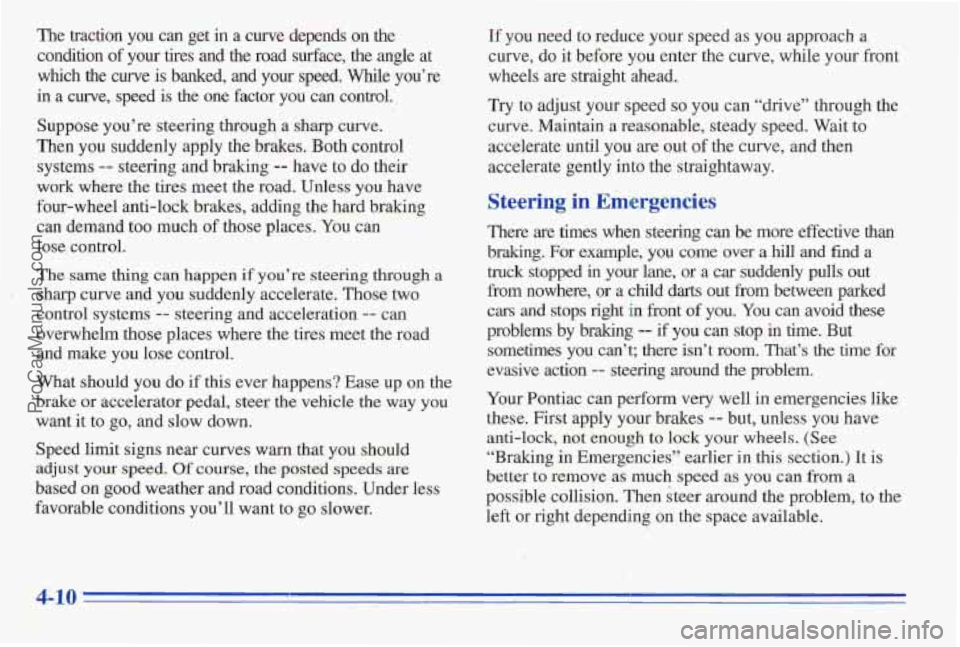
The traction you can get in a curve depends on the
condition of your tires and the road surface, the angle at
which
the curve is banked, and your speed. While you’re
in a curve, speed is the one factor you can control.
Suppose you’re steering through a sharp curve.
Then you suddenly apply the brakes. Both control
systems
-- steering and braking -- have to do ~eir
work where the tires meet
the road. Unless you have
four-wheel anti-lock brakes, adding
the hard braking
can demand too much of those places. You can
lose control.
The same thing can happen if you’re steering through a
sharp curve and you suddenly accelerate. Those two
control systems
-- steering and acceleration -- can
overwhelm
those places where the tires meet the road
and make you lose control.
What should you do
if this ever happens? Ease up on the
brake or accelerator pedal, steer the
vehicle the way you
want it to
go, and slow down.
Speed limit signs near curves warn that you should
adjust your
speed, Of course, the posted speeds are
based on good weather and road conditiolls. Under less
favorable conditions you’ll want to go slower.
If you need to reduce your speed as you approach a
curve, do it b’efore you enter the curve, while your front
wheels are straight ahead.
Try to adjust your speed so you can “drive” through the
curve. Maintain a reasonable, steady speed. Wait to
accelerate until you
are out of the curve, and then
accelerate gently into the straightaway.
Steering in Emergencies
There are times when steering can be more effective than
braking. For example, you come over
a hill and find a
truck stopped
in your lane, or a car suddenly pulls out
from nowhere, or a child darts out from between parked
cars and stops right in front of you. You can avoid these
problem
by braking -- if you can stop in time. But
sometimes you,can’t; there isn’t room. That’s the time for
evasive action
-- steering around the problem.
Your Pontiac can perform very well in emergencies like
these. First apply your brakes
-- but, unless you have
anti-lock, not enough
to lock your wheels. (See
“Braking in Emergencies” earlier in this section.) It
is
better t’o remove as much speed as you can from a
possible collision. Then steer around
the problem, to -the
left ‘or right depending on the space available.
I’ . , .I ,. ’ .~
.. . . ,.- , . . .. .
. .. :.
. . - I 1-.. -’ . ..
ProCarManuals.com
Page 166 of 370
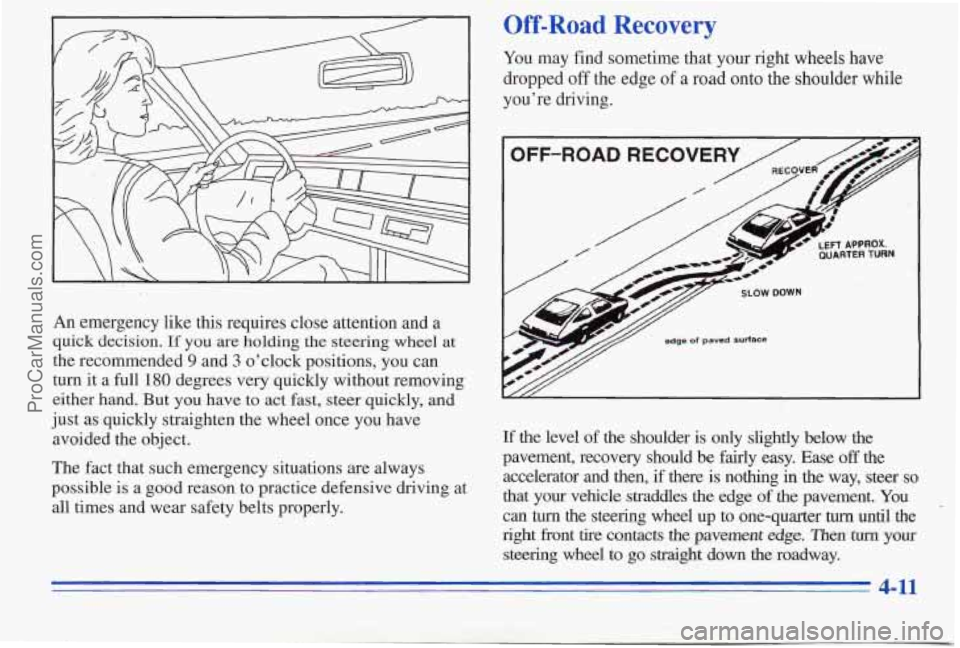
An emergency like this requires close attention and a
quick decision.
If you are holding the steering wheel at
the recommended 9 and 3 o’clock positions, you can
turn it a full
180 degrees very quickly without removing
either hand. But you have to act fast, steer quickly, and
just
as quickly straighten the wheel once you have
avoided the object.
The fact that such emergency situations are always
possible is a good reason to practice defensive driving at
all times and wear safety belts properly.
Off-Road Recovery
You may find sometime that your right wheels have
dropped
off the edge of a road onto the shoulder while
you’re driving.
OFF-ROAD
.
t- - LEFT APPROX. r-
QUARTER TURN
If the level of the shoulder is only slightly below the
pavement, recovery should be fairly easy. Ease off the
accelerator and then, if there is nothing
in the way, steer so
that your vehicle straddles the edge of the pavement. You
can turn the steering wheel up to one-quarter turn until the
right front tire contacts the pavement
edge. TRen turn your
steering wheel to go straight down the roadway.
4-11
ProCarManuals.com
Page 167 of 370
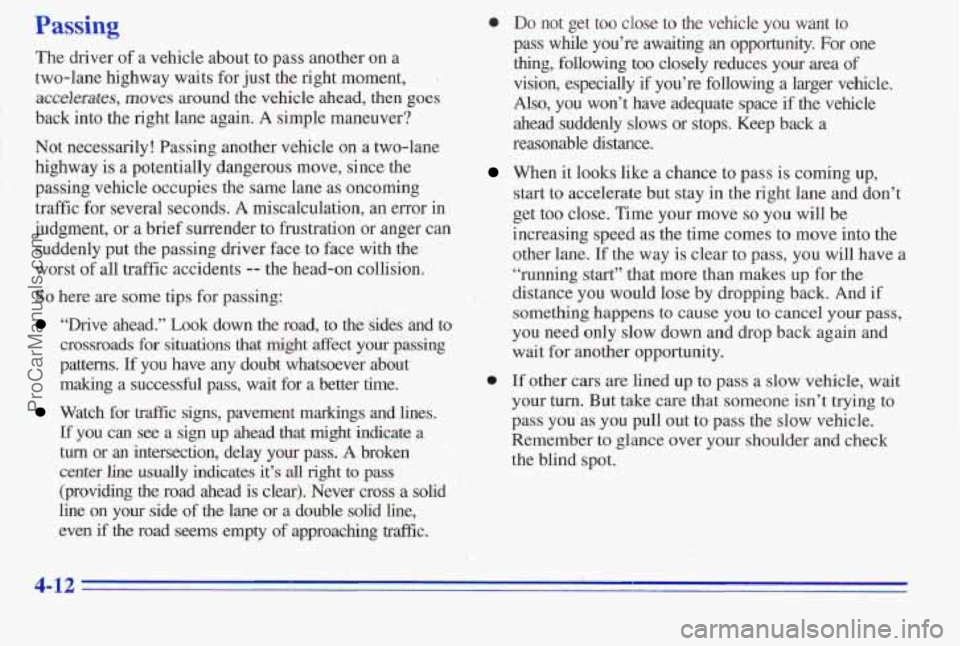
Passing
The driver of a vehicle about to pass another on a
two-lane highway waits for just the right moment,
.
accelerates, moves around the vehicle ahead, then goes
back into the right lane again.
A simple maneuver?
Not necessarily! Passing another vehicle on a two-lane
highway
is a potentially dangerous move, since the
passing vehicle occupies the same lane as oncoming
traffic for several seconds.
A miscalculation, an error in
judgment, or a brief surrender to frustration or anger can
suddenly put the passing driver face to face with the
worst of all traffic accidents
-- the head-on collision.
So here are some tips for passing:
“Drive ahead.” Look down the road, to the sides and to
crossroads
for situations that might affect your passing
patterns. If you have any doubt whatsoever about
making a successful pass, wait for
a better time.
Watch for traffic signs, pavement markings and lines.
If you can see a sign up ahead that might indicate a
turn or an intersection, delay your pass. A broken I
center line usually indicates it’s all right to pass
(providing the.road ahead is clear). Never cross
a solid
line on your side of the lane or a double solid line,
even if the road
seems empty of approaching traffic.
0 Do not get too close to the vehicle you want to
phs while you’re awaiting an opportunity. For one
thing, following too closely reduces your area of
vision, especially
if you’re following a larger vehicle.
Also, you won’t have adequate space if the vehicle
ahead suddenly slows or stops. Keep back a
reasonable distance.
When it looks like a chance to pass is coming up,
start to accelerate but stay in the right lane and don’t
get too close. Time your move
so you will be
increasing speed as the time comes to move into the
other lane.
If the way is clear to pass, you will have a
“running start” that more than makes up for
the
distance you would lose by dropping back. And if
something happens
to cause you to cancel your pass,
you need only slow down and drop back again and
wait for another opportunity.
e If other cars are lined up to pass a slow vehicle, wait
your turn. But take care that someone isn’t trying to
pass
you‘as you pull out to pass the slow vehicle.
Remember to glance over your shoulder
and check
the blind spot.
ProCarManuals.com
Page 168 of 370
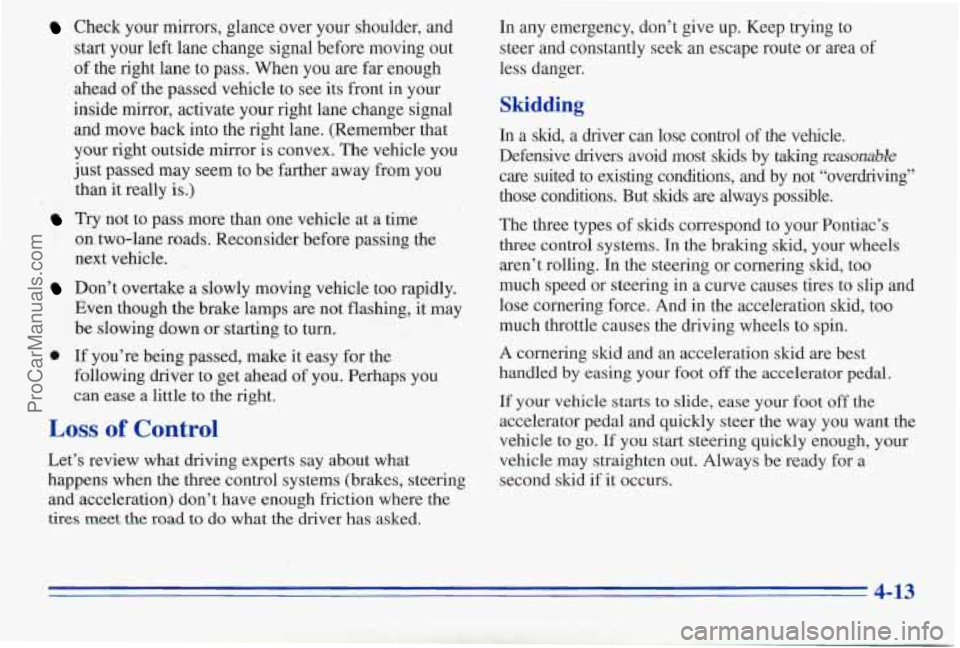
Check your mirrors, glance over your shoulder, and
start your left lane change signal before moving out
of the right lane to pass. When you are far enough
ahead of the passed vehicle to see its front in your
inside mirror, activate your right lane change signal
and move back into the right lane. (Remember that
your right outside mirror
is convex. The vehicle you
just passed may seem to be farther away from you
than it really
is.)
on two-lane roads. Reconsider before passing the
next vehicle.
Don’t overtake a slowly moving vehicle too rapidly.
Even though the brake lamps are not flashing, it may
be slowing down or starting to turn.
Try not to pass more than one vehicle at a time
0 If you’re being passed, make it easy for the
following driver to get ahead of you. Perhaps you
can ease a
little to the right.
Loss of Control
Let’s review what driving experts say about what
happens when the three control systems (brakes, steering
and acceleration) don’t have enough friction where
the
tires meet the road to do what the driver has asked. In
any emergency, don’t give up. Keep trying to
steer and constantly seek an escape route or area
ot
less danger.
Skidding
In a slud, a driver can lose control of the vehcle.
Defensive drivers avoid most skids by
taking reasonable
care suited to existing conditions, and by not “overdriving”\
those conditions. But skids
are always possible.
The three types of skids correspond to your Pontiac’s
three control systems.
In the braking skid, your wheels
aren’t rolling. In the steering or cornering skid, too
much speed or steering in a curve causes tires to slip and
lose cornering force. And in the acceleration skid, too
much throttle causes the driving wheels
to spin.
A cornering skid and an acceleration skid are best
handled by easing your foot
off the accelerator pedal.
If your vehicle starts to slide, ease your foot off the
accelerator pedal and quickly steer the way you want the
vehicle to go.
If you start steering quickly enough, your
vehicle may straighten out. Always be ready for a
second skid if it occurs.
ProCarManuals.com
Page 169 of 370
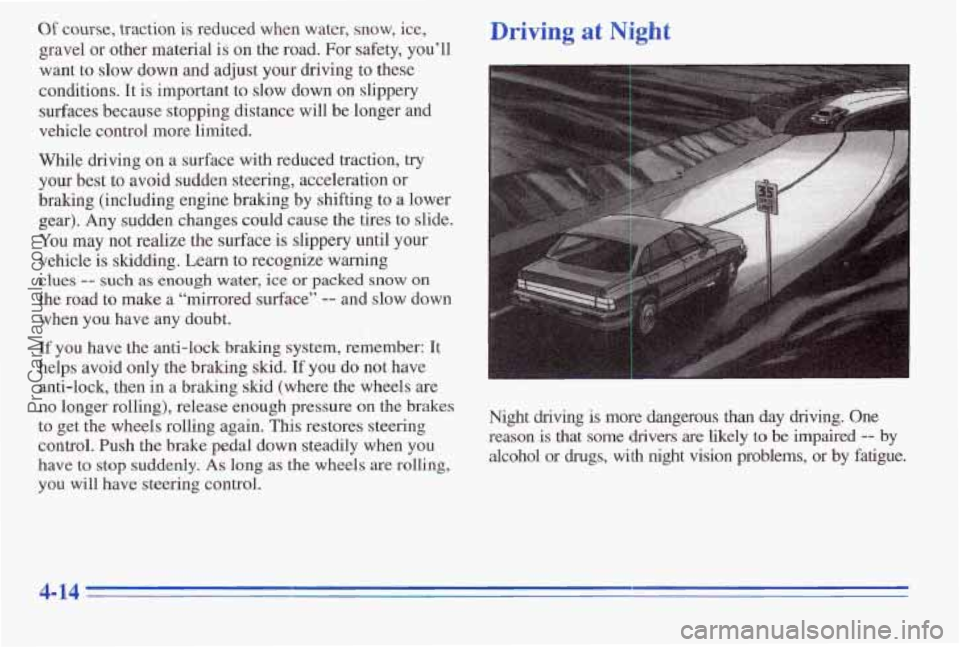
Of course, traction is reduced when water, snow, ice,
gravel or other material is on the road. For safety,
you’ll
want to slow down and adjust your driving to these
conditions. It is important to slow down on slippery
surfaces because stopping distance will be longer and
vehicle control more limited.
While driving on
a surface with reduced traction, try
your best to avoid sudden steering, acceleration or
braking (including engine braking by shifting to a lower
gear). Any sudden changes could cause the tires to slide.
You may not realize the surface is slippery until your
vehicle is skidding. Learn to recognize warning
clues -- such as enough water, ice or packed snow MI
the road to make a “mirrored surface” -- and slow down
when you have any doubt.
If you have the anti-lock braking system, remember: It
helps avoid
only the braking skid. If you do not have
antblock, then
in a braking skid (where the wheels are
Driving at Night
no longer rolling), release enough pressure on the brakes
to get the wheels rolling again. This restores steering
control. Push the hake pedal
down steadily when you
have to
stop suddenly. As long as the wheels are rolling, Night
driving is more dangerous than day driving. One
reason is
that some drivers are likely to be impaired -- by
alcohol QT drugs, with night vision problems, or by fatigue.
you
will have steering control.
4-14
~.
ProCarManuals.com
Page 170 of 370

Here are some tips on night driving.
0 Drive defensively.
0 Don’t drink and dnve.
0 ,Adjust your inside rearview mirror to reduce the
Since you can’t see as well, you may need to slow
glare from headlamps behind you.
down and ke,ep more space between you and
other vehicles.
Slow down, especially on higher speed roads. Your
headlamps can light up only
so much road ahead.
In remote areas, watch for animals.
0 If you’re tired, pull off the road in a safe place
and rest.
Night Vision
No one can see as well at night as in the daytime. But as
we get older these differences increase.
A 50-year-old
driver may require at least twice as much light to see the
same thing at night as a 20-year-old.
What you do in the daytime can also affect your night
vision. For example, if you spend the day in bright
sunshine you are wise to wear sunglasses. Your eyes will
have less trouble adjusting to night. But if you’re
driving, don’t wear sunglasses at night. They may cut
down on glare from headlamps, but they
also make a lot
of things invisible.
You can be temporarily blinded by approaching
headlamps. It can take a second or two,
or even several
seconds, for your eyes to readjust to the dark. When
you
are faced with severe glare (as from a driver who
doesn’t lower the high beams, or a vehicle with
misaimed headlamps), slow down a little. Avoid staring
directly into the approaching headlamps.
Keep your windshield and
all the glass on your vehicle
clean
-- inside and out. Glare at night is made much
worse by dirt
on the glass. Even the inside of the glass
can build
up a film caused by dust. Dirty glass makes
lights dazzle and flash more than clean glass would,
making the pupils of your eyes contract repeatedly.
Remember that your headlamps light
up far less of a
roadway when you are in a turn or curve. Keep your
eyes moving; that way, it’s easier to pick out dimly
lighted objects. Just as your headlamps should be
checked regularly for proper aim,
so should your eyes
be examined regularly. Some drivers suffer from night
blindness
-- the inability to see in dim light -- and
aren’t even aware
of it.
4-15
ProCarManuals.com